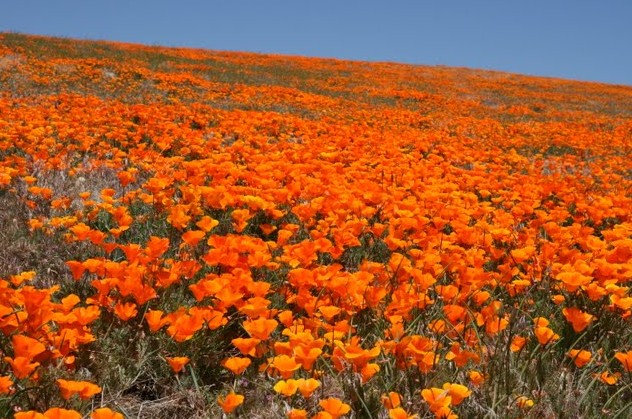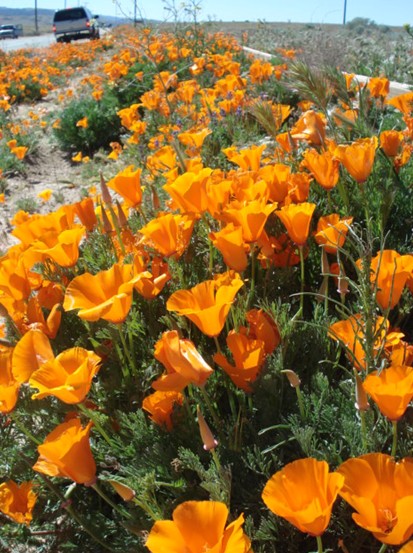California Poppy seed Eschscholzia californica
Flower Color: Shiny petals in orange to gold
Plant Type: Perennial in warm areas. Grown as annual in colder regions.
Flower Type: Poppy-like
Soil preference: Adaptable in any soil except heavy clay.
Sun/Shade: Full sun
Moisture Requirements: Average moisture, well-drained.
Germination: California Poppy seed germinates in 15 – 30 days
Optimum soil temperature for germination: 60F – 70F
Sowing depth: 1/16"
California Poppy Seed Overview
The bright orange California Poppy wildflower (Eschscholzia californica) was named for doctor-naturalist Johann Friedrich Gustav von Eschscholtz (somehow the "t" in his name got dropped), who was the surgeon for the Russian expedition team that dropped anchor in San Francisco in 1815 in a bay surrounded by hills covered with the golden flowers. It was designated the state flower of California in 1903, and is now protected by state law prohibiting anyone from picking or destroying it.
Native to western North America, California poppy is the most widespread of the 15 species of Eschscholzia found in California. Its range extends from southwestern Washington State south to Baja California, and east to western Texas. The species is quite variable, and there are two subspecies recognized which interbreed freely in cultivation. But this species has been transported to many other parts of the world, both as a garden plant and inadvertently.
There are several other wild flower species in both desert and coastal habitats which can be planted by seed. On the hillsides of California, California poppies tend to make their greatest shows on grazed lands since the animals avoid eating the bitter-tasting plants and eliminate most of the poppy's competition.
Despite it's mild-weather origins, California poppy seed will grow quite well in cold climates, but only as an annual. It can be used in beds, borders, and in naturalized areas, but generally does not do well in containers. The brilliant orange types of California Poppy work well with purple and yellow flowers, but may clash with some colors in the garden; yellow varieties combine well with blue cornflower and larkspur. Even though California Poppy is technically an annual wildflower, it is known for reseeding itself. Therefore, if you do not mow down California Poppy before it drops its seed, that seed will lay dormant of the winter and then sprout brand new California Poppies the next spring. Many wild flower seeds perform this way.
These short-live perennial wildflower plants in the poppy family (Papaveraceae) have attractive, finely divided and lacy bluish-green leaves. The plants only grow about 12 to 18 inches tall. Tapered buds open into long-lasting flowers with 4 satiny petals arranged in a cup of 2 to 3 inches in diameter. They close at night or in cold, windy weather and open again the following morning, although they may remain closed in cloudy weather. The flowers of the species varies from dark yellow to orange, but plant breeders have expanded the range to include white, pale yellow, pink, purple, red and rose colors, and double or semi-double blossoms.
Interestingly, in their native habitat California poppy wild flower is pollinated by beetles; this job has been taken over by the European honey bee in other areas. Once pollinated, the petals fall away as narrow, ribbed seed pods three inches or longer form. Eventually the pod dries out and splits, shooting tiny black poppy seeds all over. To collect the wildflower seeds, gather ripe pods just as they are just beginning to split, place in an open container and allow them to dry for a few days before removing the California poppy seeds.
California poppies require full sun and good drainage to flourish, so are particularly well suited to rock gardens and dry, sandy soils. Because it develops a deep taproot they do not transplant well, and therefore should be seeded directly in the garden where you want them to grow. Although very small seedlings can be transplanted with care, self-seeded volunteers may be of inferior quality for this particular wild flower seed.
Planting California Poppy Seed
Direct sow California poppy seed early in the spring. Rake the soil to prepare the seed bed, cover the seed about 1/4 inch deep, and keep the soil moist after planting until the seeds germinate in 15 to 30 days, depending on the temperature. Thin to about 12 inches apart. Decrease watering after the plants begin to flower. Deadhead spent flowers to prolong blooming and enhance the appearance of the plant. Removing spent flowers and seed pods will also reduce re-seeding. You may use a low nitrogen fertilizer like 3-18-18 liquid fertilizer to promote good root growth without the foliar wildflower seed growth.


